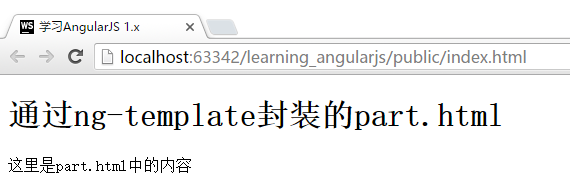外观
使用templateUrl获取模板
作者:guo-zi-xin
更新于:2 年前
字数统计:684 字
阅读时长:2 分钟
有些时候,Directive中的模板template会变得很大,如果仍然放置在定义中,那么可能会造成阅读和修改不方便的情况。
针对这种情况,我们可以将template替换为templateUrl,通过引入外部文件的形式来调用布局。
例如:
javascript
var App = angular.module("App", []);
App.directive("formDirective", function () {
return {
restrict: "A",
scope: {
},
templateUrl:"part.html"
}
});
App.controller("FirstCtrl", function ($scope) {
});html
<!DOCTYPE html>
<html lang="zh" ng-app="App">
<head>
<meta charset="UTF-8">
<title>{{"学习AngularJS 1.x"}}</title>
<link href="css/style.css" rel="stylesheet">
</head>
<body>
<div ng-controller="FirstCtrl">
<div form-directive></div>
</div>
<script type="text/javascript" src="components/angular/angular.js"></script>
<script type="text/javascript" src="js/app.js"></script>
</body>
</html>同时,我们还要加入一个新的html文档。为了演示,我们将新建的文档放置在和index.html同一个目录,命名为part.html:
html
<h1>part.html</h1>
<p>这里是part.html中的内容</p>运行效果:

ng-template
除了直接将HTML部件存储为独立的文件,我们也可以直接使用AngularJS提供的ng-template功能。这点在第四章中也有提到,这里是一个新的示例,帮助您对比物理文件和ng-template文件的优先级。
例如:
html
<!DOCTYPE html>
<html lang="zh" ng-app="App">
<head>
<meta charset="UTF-8">
<title>{{"学习AngularJS 1.x"}}</title>
<link href="css/style.css" rel="stylesheet">
</head>
<body>
<!-- 代码片段开始 -->
<script type="text/ng-template" id="part.html">
<h1>通过ng-template封装的part.html</h1>
<p>这里是part.html中的内容</p>
</script>
<!-- 代码片段结束 -->
<div ng-controller="FirstCtrl">
<div form-directive></div>
</div>
<script type="text/javascript" src="components/angular/angular.js"></script>
<script type="text/javascript" src="js/app.js"></script>
</body>
</html>这里,我们保留了上个例子中的所有文件(包括独立的part.html),对JavaScript也未进行任何修改。
运行效果如下:

要使用这个功能,我们需要在<script>标签中,首先声明type="text/ng-template",并给这段代码进行命名,示例代码中的id="part.html"即是这部分HTML代码片段的命名。使用时,直接使用part.html即可。
这样进行封装,与函数封装调用的概念类似。当默认HTML进行展示时,是不会显示这段代码的。而通过id调用后,又可以直接展示出来。
注意:通过示例我们可以看到,文档中的
part.html的优先级高于独立的HTML文件。
使用函数获取templateUrl
templateUrl的特性与我们在第四章学习的ng-include类似,也支持通过函数来获取最终的url地址。例如:
javascript
App.directive("formDirective", function () {
return {
restrict: "A",
scope: {},
templateUrl: function () {
return "part.html";
}
}
});运行效果与上面的图片一致,就不重复展示了。
